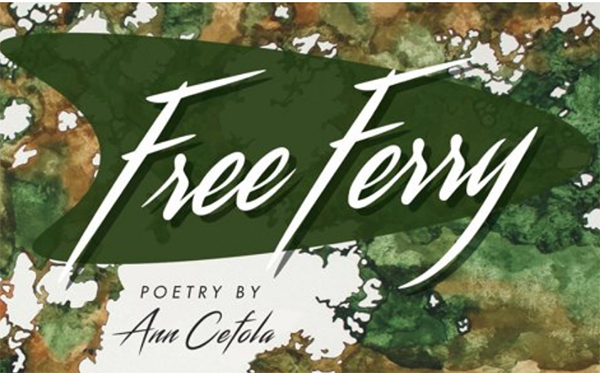A Growing America in the Nuclear Age
By Linda Simone

Linda Simone’s poetry publications include Archeology (Flutter Press, 2014) and Cow Tippers (Shadow Poetry Press, 2006). Her poems, essays, and book reviews appear in numerous journals and anthologies. Born and raised in New York, she now lives in San Antonio, Texas, where the landscape and culture have inspired many new poems. [gap]
 FREE FERRY by Ann Cefola (Upper Hand Press, April 2017). 68pp, $15.00.
FREE FERRY by Ann Cefola (Upper Hand Press, April 2017). 68pp, $15.00.
What was life like in mid-twentieth-century America? In the book-length poem, Free Ferry, veteran poet Ann Cefola provides a nostalgic journey into the Cold War era and beyond. Her concept poem, her fifth poetry publication, experiments with the interplay of two parallel yet distinct narratives, at once, personal, universal, and frighteningly connected. Both explore the joys, mundanities, and complexities of existence between the 1940s through the early 1960s.
The long poem is comprised of a preface and fifty-six sections. The preface title, [orrery], I admit, sent me to the dictionary for clarity. I learned the word alludes to a mechanical model of sun, moon, and planets that serves to illustrate or predict their relative positions. This sets the scene for the journey that follows, “Longing, like genetic code—for another time, continent, sound. …Parallel universe.” Cefola challenges us to experience (or re-experience) a time (in the words of iconic songstress, Astrud Gilberto):
…when people in the States wanted
to turn to something other than their troubles.
There was a feeling of dissatisfaction—possibly
the hint of war—and people needed some
romance, something dreamy, for distraction.
The top narrative is in the voice of a five-year-old child, witness to the grown-up world of her parents—tellingly named Orpheus and Eurydice. Cefola ferries the reader into the “crenellated kingdom we call home.” In musical language, the young speaker paints their perfect suburban life: movie-star-beautiful parents, cocktail parties against the sound track of Bossa Nova and Big Band music, “cigarettes in little silver urns—”, the salve of an ever-faithful best friend. She flawlessly recreates the era of Easy Bake Ovens, The Mickey Mouse Club, and an Empire State Building (at the time, the world’s tallest building), standing “like a one-feathered chief.” As we traverse this utopia (“Suburbia. But on its edge.”), however, the world-at-large cannot totally be shut out. The young speaker must practice duck-and-cover drills in school, and backyard bomb shelters (“A place you go to survive, which always makes me wonder: / What about the rest of us, left outside?”) are not uncommon.
The lower narrative, a kind of Underworld, responds with espionage, highly classified information, and complicated scientific formulas that ultimately explode into the discovery of plutonium and, ultimately, the atomic bomb. The diction here is terse and markedly more adult. This storyline moves from the general circumstances leading to the Manhattan Project to the laser-focused view of the immigrant-turned-chemist whose intelligence and genius entangle him in a frightening top-secret web.
The book’s beauty lies in its linkages and echoes. Take, for example, the section titled [bomb shelter]. On the upper reach, the speaker describes these shelters, familiar to anyone living through or reading about that era. In the lower subtext, a Japanese neighbor of the chemist is nearly in tears remembering his home town sheltered from the atomic fire only because of its antiquities.
[television] is a trip down memory lane, recounting period programs, like “the fat man” (Jackie Gleason) and the June Taylor Dancers who “flash legs seen above / like a chrysanthemum.” In the scientific underworld, “Fat Man” resonates as the code name for the plutonium bomb dropped on the city of Nagasaki on August 9, 1945.
In [manual], hands are the subject of both narratives. At the top, the hands of the child/speaker’s mother are lovingly captured in black and white by her father “To photograph your own heart, held”; at bottom, the chemist, asks for a schoolteacher’s hand in marriage.
In the final section, [passage], there is the river to be crossed—Styx? Lethe?—where “beauty unfolds its blue-green eye, grace” to be “by the river’s own waves erased”. And below, the awful beauty, “A blistering / lodestar.”
Cefola’s language, metaphors, and attention to detail are striking. She masterfully chooses words in the top narrative (“igniting sun,” “dazzling,” “condensed like breath,” “unearthly glow”) that foreshadow the explosive lower storyline. The narrative is expertly complemented by David Provolo’s pitch-perfect book design. The cover’s watercolor painting by Linda Gall depicts innocent children at play under the threatening cloud of the “atomic boomerang”—a popular graphic element from that era.
Free Ferry is a complex poem, layered, nuanced, and evocative. In light of the recent seventy-fifth anniversary of the first weighing of visible Plutonium (accomplished by the poem’s chemist on September 10, 1942)—and the current chaotic state of world affairs, Free Ferry provides a hauntingly relevant view that calls me back to the page again and again.


Linda, I cannot thank you enough for your focused and penetrating attention to Anne’s work. To put a great book in the hands of an audience as fine as the writer is the heart’s delight of a publisher. Thank for reading, thinking, and writing so generously. What a remarkable, generous gift! With deep thanks, Ann Starr–Publisher of Upper Hand Press